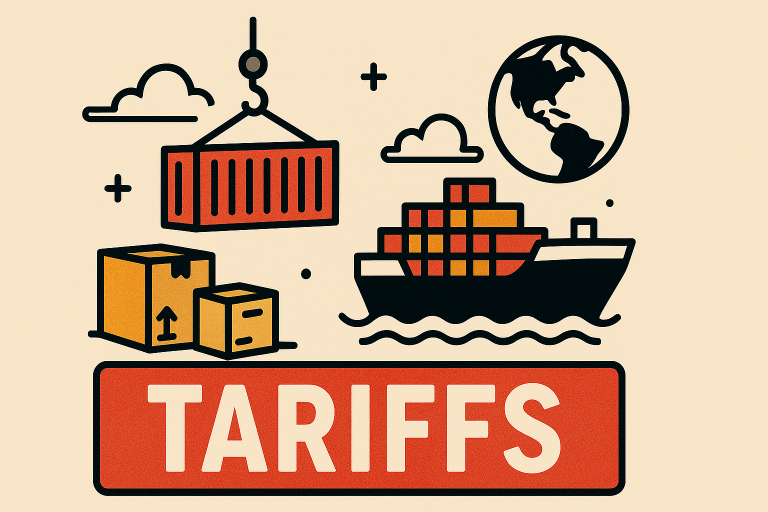I’m not going to beat around the bush, folks. The first five trading days of April were devastating.
The S&P 500, Dow and NASDAQ all sold off hard, with all three indices falling more than 10%. Few stocks were spared, as the baby was thrown out with the bathwater.
In fact, Bespoke Investment Group pointed out that the stock market’s three-day plunge (April 3, 4 and 7) was one of the worst three-day trading spans since late 1952.
Percentagewise, this recent three-day decline is comparable to the COVID-19 pandemic and the 2008 Financial Crisis. According to Bespoke, the only three-day decline that was worse occurred during the 1987 crash.

The fact is Wall Street had a very emotional response to President Trump’s so-called “Liberation Day” tariff announcement last Wednesday.
But, as I have discussed in recent Market 360 articles, the Trump administration has a few primary goals with the reciprocal tariffs. So, today, I’m going to briefly recap them, and then I’m going to share three green shoots that are emerging despite this volatile period. Plus, I’ll reveal what investors should be watching for next, as this event could make or break portfolios.
Goal No. 1: Level the Playing Field
The reciprocal tariffs are, first and foremost, a negotiating tactic.
If you looked at any of the tables that laid out the U.S. reciprocal tariffs alongside the tariffs that other countries and nations have on the U.S., then the trade imbalances were crystal clear. And in some cases, the new reciprocal tariffs are still not level with other countries’ levies on the U.S.

So, President Trump shocked everyone when he introduced reciprocal tariffs across the board. No trading partner was spared. At least 10% tariffs were imposed on everyone.
Those countries with persistent trade imbalances were slapped with even bigger tariffs. As an example, China was hit with a 34% tariff (compared to its 67% tariff on the U.S.), and Vietnam was hit with a 46% tariff (compared to its 90% tariff on the U.S.).
In the wake of the reciprocal tariff announcement on Wednesday, there’s been a lot of backlash from countries around the world. But interestingly, most are coming to the negotiating table rather than retaliating with more tariffs. This includes the European Union (EU), the U.K., Switzerland and Singapore.
So, new trade talks will ensue, and new trade deals are anticipated.
Goal No. 2: More Onshoring
On Thursday, April 3, the 25% tariffs on U.S. auto imports were also officially implemented – and auto manufacturers have started to respond. But the response has been along the lines of what President Trump was hoping for… more onshoring.
Back in late March, Hyundai revealed its plans to invest about $21 billion in U.S. onshoring, including a $5.8 billion steel plant. This week, Mercedes-Benz noted that it will consider manufacturing more vehicles in the U.S., and Volvo plans to boost the number of cars it makes in the U.S.
So, Trump’s plan to have more vehicle, technology and pharmaceutical companies onshore operations could ultimately bring trillions back to the U.S.
Goal No. 3: Raise Revenue
White House aide Peter Navarro recently stated that the reciprocal tariffs will boost the U.S.’s revenue by $6 trillion in the next 10 years. He noted that the figure doesn’t include the tariffs on vehicles. Tariffs on vehicles are anticipated to generate about $100 billion each year.
Whether that is accurate or not, one thing is clear: The Trump administration seems to want a 10% tariff on everybody, period. And that’s essentially the equivalent of a VAT (value-added tax) tax.
The reality is we have a big underground economy in America. And getting a VAT passed in the U.S. to help address the deficit is politically unpopular, so we just have to do the tariff.
That’s what Trump is doing, and the White House has never explained this properly.
Additionally, more onshoring clearly equals more revenue for the U.S. And if more corporations onshore and investment pours into the U.S., that will boost revenue, and then income taxes could be lowered.
Three Green Shoots Emerging
We now have a lot more clarity on the Trump administration’s tariff plans and what it hopes to accomplish. This clarity, though, did little to quell Wall Street’s concerns. But the good news is that there are already some “green shoots” emerging…
1. China is the only country that has slapped back with retaliatory tariffs so far. You should first know that there was already a 20% tariff on China. Then the tit-for-tat began as Trump announced another 34% on Wednesday, causing China to retaliate with it’s own 34% on Friday. This impacts all U.S. goods, as well as a restriction on rare earth exports to the U.S. The Trump administration hit back with an additional 50% tariff today, bringing the total tariff on Chinese goods to 104% (it will go into effect at midnight tonight).
However, most other countries and nations are more willing to come to the negotiating table. In fact, the White House reports that it has been contacted by more than 50 nations that are willing to lower their tariffs. The White House plans to stick with the 10% baseline tariffs, but everything above 10% may be negotiable.
Folks are starting to see some evidence that trade barriers could actually fall. Israel set the standard yesterday by announcing plans to eliminate its trade deficit with the U.S. and eliminate trade barriers.
What’s more, reports indicate that talks between the U.S. and Japan could be progressing. So, the irony is we might have freer trade as a result of the Trump administration’s tariffs, but it all has to be negotiated first.
2. Treasury yields have plunged. The 10-year Treasury yield fell as low as 3.9% on Friday, compared to 4.37% on March 26 and 4.79% in mid-January. The 10-year Treasury yield now sits at about 4.26%.
This is important, folks. First, it lowers borrowing costs for funding our government. It also lowers the cost for individuals and businesses, as the 10-year is a key benchmark for lenders.
But most importantly, remember that the Federal Reserve never fights market rates. And falling Treasury yields should push our central bank to cut key interest rates several times this year. In other words, my prediction that the Fed will cut rates at least four times this year may now come to fruition.
And I’m not the only one who thinks so… Three rate cuts were priced into the stock market – but following last week’s tariff announcement and fears of slowing global growth, the stock market briefly priced in five 0.25% rate cuts this year.
3. Energy prices, egg prices and mortgage rates are all falling. Crude oil prices are now at their lowest level in three years, with Brent crude oil at about $62 per barrel and West Texas Intermediate crude at about $59 per barrel. Wholesale egg prices have declined 43% since the start of the year. And 30-year fixed mortgage rates dropped by 20 basis points in the past week, which could help spark the housing market.
Now, I don’t expect this to be reflected in the inflation reports due later this week. (Stay tuned for my coverage on that in Market 360.) But it could show up in subsequent reports, which could help the Fed feel more confident in cutting rates.
The Bottom Line
Overall, I know the market’s reaction to the Trump 2.0 tariffs has been painful.
Recent selling in the stock market has been severe, but it’s come on high trading volume, so we should get a reversal (we got a taste of that reversal today). With that said, though, the market may need to retest its recent lows. So, wild oscillations could persist in the near term.
Hopefully, volatility will diminish as trading volume exhausts itself in the upcoming weeks.
After that, headlines about tariffs diminishing or the Fed cutting key interest rates could be the “spark” that reignites the market and encourages cash to come off the sidelines.
But here’s the thing…
President Trump’s tariffs are only the tip of the iceberg.
That’s because a financial tsunami is coming our way.
This growing tech threat will be devastating for most Americans.
But it will also make a small group rich beyond their wildest dreams.
It’s poised to widen the gap between the “Haves” and the “Have Nots” … Permanently changing our economy, rewriting the rules between companies and employees – as well as citizens and the government.
It will also dramatically affect your portfolio and your ability to retire.
That’s why I created a special presentation – because it’s absolutely critical to make investments in yourself, in your business, and in your portfolio to ensure that you survive and thrive the coming wave of change.
Click here to watch my urgent warning now.
Sincerely,

Louis Navellier
Editor, Market 360

